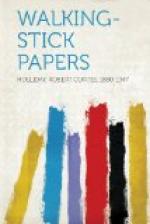You will by now have begun to perceive the note, the flair, of my part of town. Its care is for the graces, the things that sweeten life, the refinements of civilisation, the embellishments of existence. Nothing more clearly, strikingly, bespeaks this than the proofs of its extraordinary fondness for art—I have mentioned literature. Painting and sculpture, music, the drama, and the art of “interior decoration,” these things of the spirit have their homes without number along this stretch of Broadway.
“Art” shops and art “galleries” are on every hand. In the windows of these places you will see: innumerable French mirrors; stacks of empty picture frames of French eighteenth-century design, at an amazingly cheap figure each; remarkably inexpensive reproductions in bright colours of Sir Joshua, Corot, Watteau, Chardin, Fragonard, some Italian Madonnas; an assortment of hunting prints, and prints redolent of Old English sentiment; many wall “texts,” or “creeds”; a variety of the kind of coloured pictures technically called, I believe, “comics”; numerous little plaster casts of anonymous works and busts of standard authors; frequently an ambitious original etching by an artist unknown to you; and an occasional print of the “September Morn” kind of thing; together with many “art objects” and a great deal of “bric-a-brac.” Upon the windows you are informed that “restoring,” “artistic framing,” “regilding,” and “resilvering” are done within. And, in some cases, that “miniatures” are painted there. There are, too, a number of “Japanese art stores” along the way, containing vast stocks of Japanese lilies living in Japanese pans, other exotic blossoming plants, pink and yellow slippers from the Orient, and striking flowered garments like a scene from a “Mikado” opera.
In this part of town photography, too, is made one of the fine arts. You do not here have your photograph taken; you have, it seems, your “portrait” made. “Home portraiture” is ingratiatingly suggested on lettered cards, and, further, you are invited to indulge in “art posing in photographs.” The “studios” of the photographers display about an equal number of portraits of children and dogs. The people of this community take joy not only in the savour of art, and in taking part in its professional production, but they would themselves produce it, as amateurs. The sign “Kodaks” is everywhere about, and “enlarging” is done, and “developing and printing for amateurs” every few rods. So we come to the subject of music.
Caruso, Melba, Paderewski, Mischa Elman, Harry Lauder, Sousa, Liszt, Beethoven, Chopin, Wagner, Brahms, Grieg, Moszkowsky, the “latest song hit” from anything you please. Ask and you will find along this thoroughfare. There are no more prosperous looking bazaars on this street than those consecrated to the sale of “musical phonographs” of every make. And if the name of these places is not exactly legion, it is something very like that. Besides every species of Victophone and Olagraph, the music lover may muse upon the wonders and the variety of “mechanical piano players.” All of de luxe “tone quality.”




